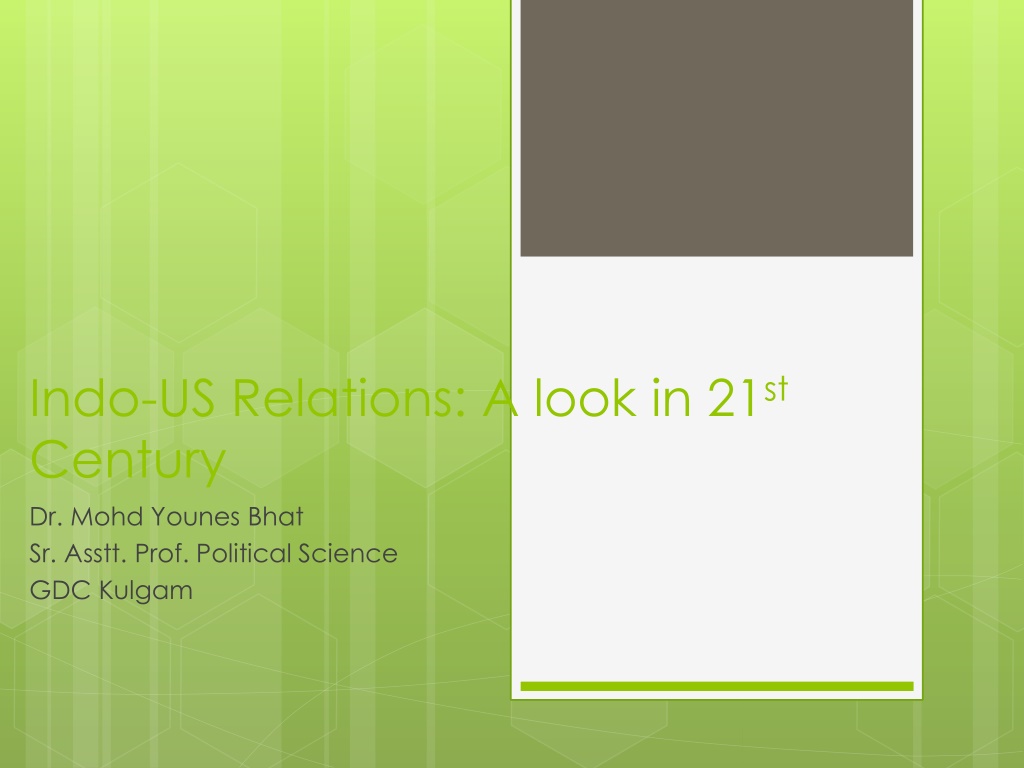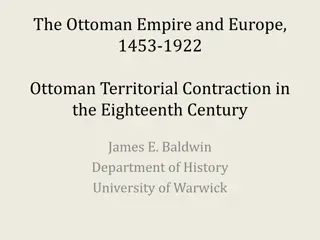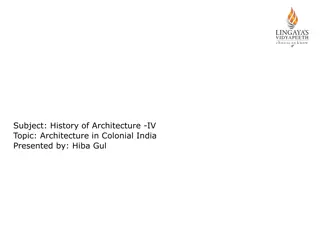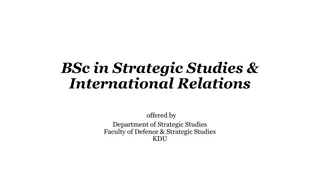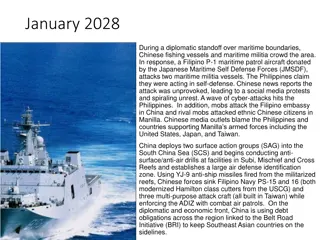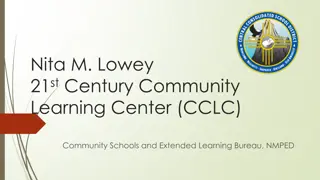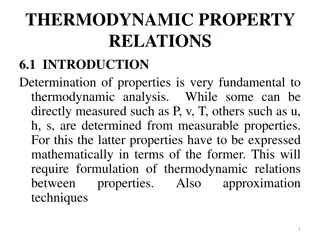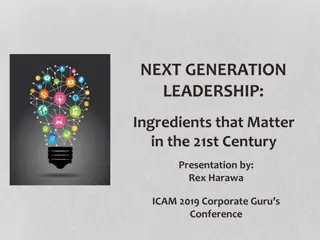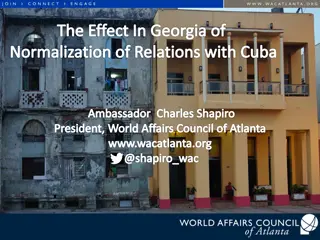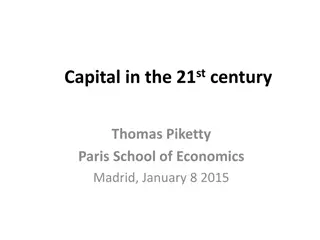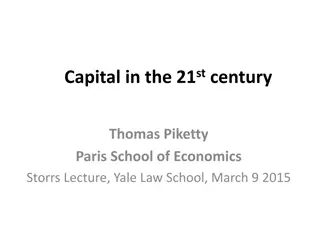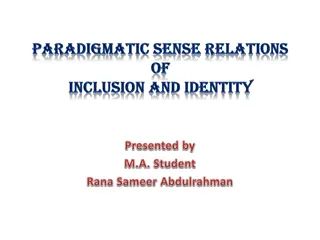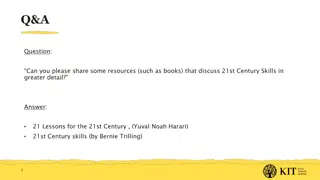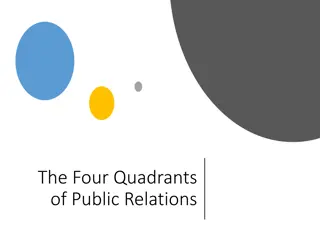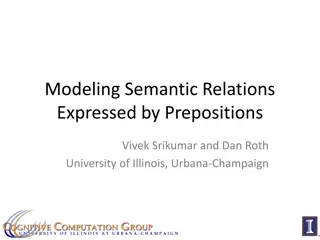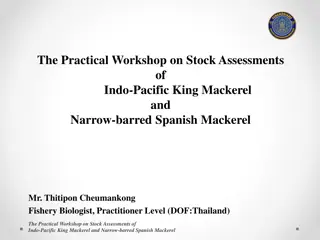Evolution of Indo-US Relations in the 21st Century
Indo-US relations have evolved significantly post the bilateral nuclear agreement in 2005. The relationship has moved beyond cold war dynamics to encompass cooperation in various spheres such as security, clean energy, democracy promotion, health, cyber security, and terrorism. There is a growing consensus on the importance of fostering alignment between India and the US due to India's geopolitical and geo-economic significance. Both countries benefit from mutual cooperation in areas like trade, investment, and fighting terrorism, signaling a positive trend for the future.
Download Presentation

Please find below an Image/Link to download the presentation.
The content on the website is provided AS IS for your information and personal use only. It may not be sold, licensed, or shared on other websites without obtaining consent from the author. Download presentation by click this link. If you encounter any issues during the download, it is possible that the publisher has removed the file from their server.
E N D
Presentation Transcript
Indo-US Relations: A look in 21st Century Dr. Mohd Younes Bhat Sr. Asstt. Prof. Political Science GDC Kulgam
Objectives of the Lecture: The broader objective of the lecture is to understand where the Indo-US relationship has been placed after bilateral nuclear agreement in the year 2005. To evaluate whether the estrangement has been evaded by the nuclear agreement, what are the implementation and moved beyond the structural level. unveiling of the complexities has in its the relationship
Methodology: The lecture is primarily based on the objective study of Indo-US bilateral engagements particularly in the post nuclear agreement phase. The aspects of Indo-US convergence of interests and bilateral contestations over different issues from geopolitical to nuclear proliferation and terrorism have been analytically studied while using both historical and analytical approaches. The data governmental documents, Senate reports, Ministry of External Affairs briefings, reports of thin tank like Carnegie Endowment for International Peace, Council for Foreign Relations. The research has done a meticulous study of official documents besides secondary resources in the form of books, Newspapers, and journals. encompasses wide ranging
Summary: The Indo-US relationship has reached to a stage for fostering structural alignment on account of India s growing importance geopolitical and geo-economic spheres. There is by and large a growing consensus in the policy circles in the Washington that helping India and its rising power is in the US interest and would be a determinant in the Indo-Pacific region. Growing Indian Diaspora, unstoppable Indian economy and reaching of Indian born at the higher echelons in the Washington signal a positive trend for future. in the both
The Indo-US bilateral relationship has moved beyond the cold war proliferation lenses partnership in the areas of security, clean energy, promotion of democracy, health and partnership in cyber security and terrorism. There is now greater convergence in the areas of mutual interest from fighting terrorism to trade and investment in both the countries. rhetoric and non- towards a strategic
The India encompasses huge opportunities on account of its growing demand in infrastructure, energy, consumer products, services so on and so for. While as equally the US can be critical for the India in the areas of investment, technology knowledge in cutting edge technologies, access to new energy resources etc. Therefore, both need each other, but pursue their national interest and want to increase their respective economic, military soft power in the world. and financial transfer, sharing
The importance has been augmented on account of its growing economy, India s big businesses investments, its growing military strength and its capability for US alliance-ship in protecting sea-lanes in the Indo- pacific region. Moreover, on the geopolitical front India can lead a stability and balance of power vis- - vis emerging challenges in the from of rising China. On the global issues such as climate, terrorism, global commons, democracy, indispensable country. American consensus reads that the India s cyber security, India is
Both the states share common concerns over the global issues such as terrorism, democratization, health, disaster management, freedom of navigation, and stability in Afghanistan cyber crimes, climate,
The Indo-US nuclear agreement had been a path breaking development relationship keeping in view past nuclear discourse. However, the US put her-self in bad position on both the diplomatic front as well its hand folded non-proliferation policy. It seems it helped Indian more than US as it has put US in awkward position in the sense that it lost its moral position on non-proliferation and it is now accused for its selective approach over the non- proliferation agenda. in the bilateral
Nuclear agreement has not transformed the Indo-US relations in a big way but has opened a confidence in leadership of both the countries to move forward. It seems the deal was more romanticized due to its commercial significance particularly for the nuclear business in Washington. The actual substance of the deal do not go beyond the sense that it may have helped India to open its new channels for nuclear trade with the countries such as Russia and France and for the US the deal is still in doldrums due to the pending liability and other technical issues.
Keeping in view the controversial aspects of the nuclear energy on account of cost factor, time lags and safety measure it seems nuclear energy desirability has reduced in all over world.
There is a visible distance for deep geopolitical alignment between US and the New Delhi. The strategic culture in both the countries are different, New Delhi still balances its non-alignment policy vis- -vis new growing power equations, while as the Washington s sense of structural alignment based on reciprocity , transactionalism , and quid pro quo resultantly hampers a bilateral strategic structural alignment. Moreover, there are persistent doubts in the New Delhi over the Washington s long- term plans.
Given the specification of the growing likeness in the present geopolitical scenarios the structural constraints in the Indo-US relations has transferred from cold war to China-Pakistan geopolitical fixation. From one side the New Delhi s growing combined economic growth and a rising military capability would be a critical indefensibility for challenging Chinese growing geopolitical assertiveness in the Indo-Pacific region. On the other side both the US and the India do not want a direct confrontation with the Beijing, instead both are looking for good cooperation. The US policy is full of ambivalence. One side they ask the New Delhi to play a hedge role and at the same time looking for a G2 alliance with the Beijing.
The US geostrategic calculation in the West Asia, Asia Pacific and in the Af-Pak regions is by and large incongruent with the New Delhi s core concerns in the form of G2, assisting Pakistan and asking for participation in the battlefields in the Afghanistan and West Asia.
The ambivalences over market liberalization in India are still incoherent with the American business, as the current structures do not satisfy people in the US.
India has lesser power leverage while conceding concessions from the Washington. This would be the prime reason that New Delhi fails to convince its partner at Washington to move a broad shift in its policy on aiding Islamabad, and forging G2 alliance with the Beijing, and conceding big breakthrough in the fields of defense and sensitive technologies.
Conclusion: The structural aspect of the Indo-US relations is by and large coherent given the fact that there are numerous bilateral forums in place. But, to convert the relationship into a substance, the Washington should pursue Indo-US relationship as joint venture not an alliance partnership. The US must understand and respect India s autonomous strategic culture so that bilateral anomalies and ambivalences get evaded. Avoiding reciprocal, Washington should de-hyphenate its policy on India, China and the Pakistan, rather the focus should be how to address India s structural constraints vis- -vis strategic partnership. transactional ventures,
Washington should approach the relationship not through the lenses of quid pro quo , rather unequivocal concessions should be granted to New Delhi, if at all it is serious about Indo-US strategic partnership. Given the fact that there is a colossal difference in power capability and geopolitical reach, the US should not commit it self for reciprocate measures on the part of New Delhi. Doing that would not hit any way to the Washington s long-term interests as unilateral non- reciprocate relationship would help the US too as it would automatically balance the China in the whole region of Indo-Pacific and Washington can harness colossal amount of economic opportunities in India. If the US fail to reach the New Delhi based on the reciprocity reason, then it is likely to hit India vis- -vis managing of rising China and its strategic asset Pakistan, but it would not absolve the Washington too as it has then a definite consequences for it as well. Moreover, Washington would loose an opportunity of gaining grip over balance of power in Asia, which per se is core concern of the US.
The American exceptionalism, core policy based on democracy and liberal internationalism would get boost if the US concede unilateral concession to the New Delhi, particularly giving India full support against China. This remains doubtful in the post Trump era which is transactional in foreign policy handlings. If the Trump ignores the strategic logic that India is asset in the Asia Pacific region and in its beyond, the America may loose big opportunity.
To explore a real advantage of the nuclear agreement, US should provide India Radkowsky Thorium Fuel, Duel Communication Satellite Technology (COSMAT), without invoking licensing reciprocity clauses. The US should help India in accessing all the modern technologies in the fields of space, agriculture and innovation, global health and cyber security. Use Technology and procedures and
Given the fact that more than 90 thousand jobs in the US have created by the 100 Indian companies, therefore, the Washington should amend its laws to allow a robust collaboration between the companies particularly on co-development production. of two countries and co-
The US should not put India-US partnership hostage to the Chinese Rise and its counter measures. Putting India against China would hamper India s rising power status both in economic and political dimensions.
Given the fact that Beijings assertive political culture poses a great threat for New Delhi from the point of view of foreign policy and security. But for confronting this challenge, New Delhi should not get trapped into western theorization particularly of US. A long-term and prudent policy orientation need to be put in place which one side balances Beijing and at the same time does not lead to any one to one provocation. This can be done through a Multiple Policy Strategy, under-in New Delhi can forge substantive bilateral partnership with the countries such as Japan, US, Russia and South East Asian countries and at the same a Beijing specific prolong strategic policy need to be put in place.
The US should be more cooperative to New Delhi on terrorism The US should come forward with open arms for a substantive collaboration in addressing the energy issues in India and should share new technologies related to environment, nuclear energy, and automobile fuel efficiency.
Both the states need to recognize each others core concerns for building a real substantive bilateral relationship. If India has to come out of ambivalence over the issues of trade liberalization and some geostrategic proximity, the US need to be flexible in accepting India s reservation over a full fledged alliance partnership. At the same time the US should address the India s concerns over H-1B visa and access to latest technology in the domains of space, agriculture, climate, ITC, technologies. On the political front, the USmust address India s concerns over the Pakistan and the assertive China in the Asian geopolitics. and cutting edge
The US under the Trump administration becomes more transactional business oriented country. Expecting unilateral concessions from the incumbent Trump administration would be a na ve attitude. If the New Delhi asks Washington to relax visa rules, fix the Beijing- Islamabad geopolitical trajectories, she would be replied do more on liberalization and move its battalions in Afghanistan and West Asia, Therefore, a prudent move on the part of New Delhi would be to put in place its own indigenous policy narrative as the Washington is unreliable due its changing character bases on caste-benefit analysis.
Therefore, New Delhi should concentrate on building its domestic area strong particularly its economy and domestic technology so that it reaches the level where Washington would consider it. On the political front, New Delhi should substantially reach out to Europe, Japan and pursue a re-engagement policy towards Russia with new ideas and policy framework. The Trump s firstAmerica doctrine can be seen as an opportunity for New Delhi vis- -vis launching a multiple-alignments with both large and middle powers.
